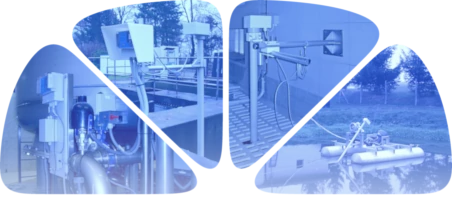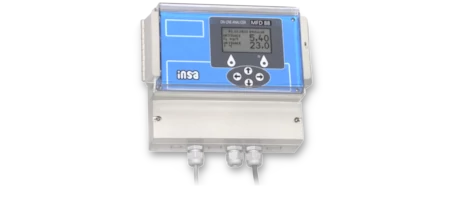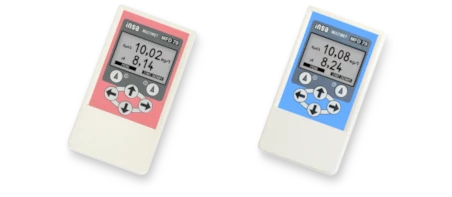Oxygen concentration: Application examples
INSA analyzers and measuring sets are used in a wide range of applications in industry, water management, and in a number of other areas. Below you will find brief information and tips on some typical applications.
Oxygen measurement at biological wastewater treatment plants
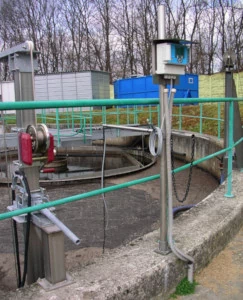
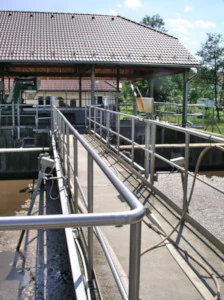
Measurement of the dissolved oxygen concentration in water is mainly used for monitoring and controlling the activation and nitrification process. A suitable concentration of oxygen minimizes the energy consumption of aeration devices and at the same time ensures optimal operation of the activation (nitrification) and denitrification stages in constantly changing operating conditions. It enables effective removal of both organic and nitrogen pollution, and minimizing the consumption of electricity, which is one of the largest costs in the operation of the WWTP.
INSA systems for measuring oxygen concentration work reliably at hundreds of treatment plants, both municipal and those connected to food technologies, tanneries, the pharmaceutic industry, at WWTPs of animal products rendering industry, etc. The devices are mostly connected either to frequency converters or to further control systems, to optimize the performance of aeration devices. The on-line analyzers can also control the aeration directly, without additional control systems.
Another part of WWTP technology, where the monitoring of oxygen concentration is important, is at the regeneration tanks of the sludge management. Measuring oxygen is also important in purification tanks and ponds. In these cases, the measurement is carried out at the minimum speed of water movement, where some kinds of oxygen sensors have problems without additional stirring. Sensors CSOT43 have extremely low oxygen consumption, while sensors CSOT53 and CSOT63 have zero consumption, so they work well in these cases, without any additional stirring. The low flow rate also does not allow self-cleaning of the sensors (unlike in the WWTP activation tanks). In these cases, INSA systems with automatic sensor cleaning have proven themselves excellently.
Sensor contamination is a challenge
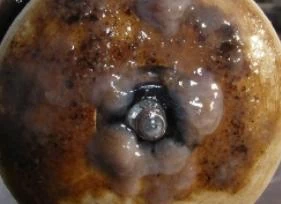
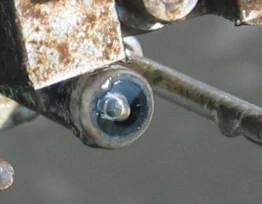
Measuring the concentration of oxygen at a WWTP is particularly difficult in cases where slime forms on the surface of the oxygen sensor. For maintenance crew, this would mean cleaning the sensor even once a day in extreme cases. In such situations, the ideal solution is automatic cleaning - the probe SPO41MEK. This completely eliminates the unpleasant manual cleaning of the sensors.
Left: Oxygen sensor without automatic cleaning, installed inside an activation tank where water contains slime microorganisms, after 1 week operation without cleaning.
Right: Oxygen sensor in similar conditions after 12 months operation with automatic cleaning, without any manual intervention.
Maintenance of the system then consists only of a simple recalibration in the air once every 6 months. The recalibration is performed by just pulling the probe out of water and starting the calibration procedure by pressing a button. The calibration then proceeds automatically, so the only remaining task is to return the probe back into water.
Automatic cleaning may provide safer operation and more comfort for the operator even in those cases where slime does not form on the sensor, or where the sensor is more or less cleaned just by the movement of the measured water. In many cases, this self-cleaning by water flow is even sufficient for normal operation, so that the automatic cleaning is not needed. Systems with automatic cleaning prove excellent also in the demanding conditions of regeneration tanks of sludge management, and in post-cleaning tanks and ponds. Even in these cases, INSA systems with automatic cleaning work without the slightest problem.
Oxygen measurement at drinking water treatment plants
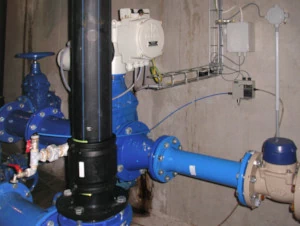
Oxygen measurement is also important in drinking water treatment plants that process surface water.
Changes in oxygen concentration indicate changes in organic load and can also signal the release of manganese into the raw water.
The oxygen concentration in the raw water also affects the operating mode of the individual technological stages of the treatment plant.
Oxygen measurement in surface water monitoring

Oxygen concentration is an important indicator of surface water pollution. In clean surface waters, the oxygen concentration is usually between 85 % and 95 % of saturation, but may become significantly lower (or higher) in biologically or chemically contaminated waters. During the daily cycle, the concentration changes due to changes in the intensity of photosynthesis. The dynamics of changes are significantly higher in strongly eutrophic waters.
Oxygen concentration measurement is an important part of any monitoring station. For these applications, it is also advantageous to use probes with automatic sensor cleaning (SPR41ME or SPO41ME), which enable long-term unattended operation of the station.
Oxygen measurement in fish farming
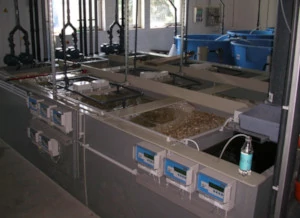
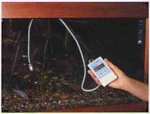
Information about the amount of oxygen in the water is vital for fishing technologies - fish farms, fish tanks, ponds. A concentration of 3 to 4 mg/l is usually considered the lower limit, depending also on the sensitivity of the fish. Salmon-like fish require a concentration of around 6 mg/l.
Depending on the nature and scope of individual facilities, the entire range of INSA instruments is used. The MKT44A pocket-size oxygen meters (bottom image) have proven themselves in the past for portable measurement of oxygen concentration in ponds, fish farms, or even for smaller stable setups. Their long tradition continues to the modernized type MFD79, which is also available with a modern optical sensor CSOT53. Just immerse the sensor in water, wait for the value to stabilize and read the concentration on the display...
For larger facilities, a better option it to use a permanently installed hanging probe CSOT63. However, continuous measurement of oxygen concentration in these situations may be relatively difficult for two reasons. One reason is the quick contamination of the sensor membrane, often seen in fish farming facilities. The second reason is the low speed of water flow, which not only requires sensors with very low oxygen consumption, but also reduces the self-cleaning of the sensors by the flow - the sensors often have to be cleaned daily under such conditions.
The INSA sensors and probes offer a solution for these cases. Oxygen consumption is very small (CSOT43 sensors), or even zero (CSOT53 and CSOT63), so they work well even without any water movement. Automatic cleaning of the sensor (SPO41ME and SPR41ME probes) enables reliable operation of the system even in the most demanding cases, requiring virtually no maintenance.
Oxygen measurement in the food industry
Oxygen plays an important role in all fermentation processes - e.g. in the production of beer. There must be a sufficient amount of oxygen in the wort for the fermentation process to be optimal. Conversely, after the end of fermentation, the oxygen concentration must be kept as low as possible.
The residual oxygen concentration determines the shelf life of the produced beverage. To achieve a long storage time, the concentration must be a few tenths of mg/l at most.
